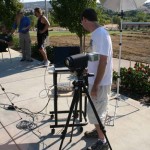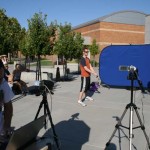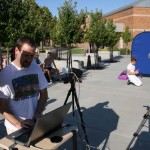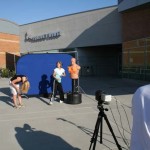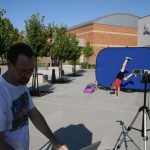Spent the afternoon filming the Women’s Golf Team. After the standard swings, the Happy Gilmore treatment:
I stumbled upon an interesting way to search for anonymous edits to the Wikipedia originating from inside of the LRCCD network.
Once you’re there, you can select “diff” for any of the articles to see the actual changes and compare them to the prior state of the document. As would be expected, the edits consist of a mix of spelling and grammar tweaks, earnest factual edits, and (often hilarious) vandalism.
It would be interesting to analyze these to determine if any of the changes map to course content. Were students so inspired by their Philosophy class that they felt compelled to edit the Wikipedia entry on Existentialism? We may never know…
For the nerds in the audience…
For security reasons, the LRCCD network “masks” real IP addresses. That is, all of the traffic coming out of ARC appears to originate from the IP address 165.196.0.10. Traffic from CRC appears to originate from 165.196.0.11, and so on. Couple this with the fact that Wikipedia records IP addresses for anonymous edits, and you have an interesting view into the edits originating from the LRCCD network, by college.
…and everyone has shampoo commercial hair.
On Thursday, September 30 2010, I teamed up with Kim Harrell (Kinesiology) to generate some high-speed camera footage of her “Kinesiology 410 – Personal Trainer Certification: Exercise Science and Fitness Assessment” class punching, kicking, jumping, running, spinning, leaping and skipping rope (among other things). Kim’s students will use the videos to study forces on the body, musculature, joint stress, etc.
We set up in front of the Roost, and many passersby stopped to watch and ask questions. The students were fired up, and each one ran over to the computer to witness their performance, critique their form, etc.
I’m scheduled to work with the golf coach on Friday, 8th October for some golf swing analysis. Good times.
Gear nerds, behold the specs:
Mikrotron MotionBLITZ Cube2 @ 1020 fps
Fujinon C22x17A-M41 w/ Fujinon CRD-2A Remote Control Box
We’ll pick it up again on the 15th of October.
After lots of technical heartache, I finally got the high-speed camera back up and running. Candy Smith and Gerry Tryhane were talking to some students, and I was able to convince one of them – the students, not Candy or Gerry – to jump for the camera. This video is about ~1100 frames per second. Kim Harrell (Kinesiology) is going to have her students jump, and use the footage to analyze forces on the body, or something like that. Stay tuned.
Google announced the winners of its Project 10 to the 100 prize. Among the winners – The Khan Academy (http://khanacademy.org/) Seems like a win for OER. Did you know that FLC is a member of the Community College Consortium for Open Educational Resources?
This vid seems to be a pretty perfect description of my vision of the Online Educators group.
http://www.nytimes.com/2010/09/19/magazine/19FOB-WWLN-Kelly-t.html
Take-aways for me:
“Before you can master a device, program or invention, it will be superseded; you will always be a beginner. Get good at it.”
Wow. Exactly. This is the definition of critical thinking.
“Nobody has any idea of what a new invention will really be good for. The crucial question is, what happens when everyone has one?”
Profound. What if all educators thought this way?
Learn how to use Google Docs – a suite of free, web-based tools – to create, edit and share documents quickly and easily. Google Docs is a great tool for department and committee document creation, storage and access, and for use with student groups. You can access Docs from any Internet-connected computer, and most mobile devices.
Friday, September 24
10 – 11 AM
FL1-130 (Innovation Center) FL1-35 (Library Classroom)

